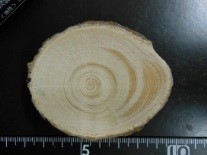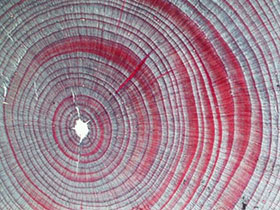Home > International Partnerships > Collaborative Research > Reconstructing Development of Drunken Forest and Soil Hummocks to Analyze the Effects of Climate Warming on Permafrost
Update:November 18, 2020
Main content starts here.
Reconstructing Development of Drunken Forest and Soil Hummocks to Analyze the Effects of Climate Warming on Permafrost

1. Partners
Saskatchewan University, Canada
Aurora Research Institute, Canada
Shinshu University, Japan
2. Research Period
FY 2017-2019 Grant-in-Aid for Scientific Research (KAKENHI)
3. Lead Researcher
FUJII, Kazumichi (Department of Forest Soils)
4. Background
Climate change could have huge impacts on permafrost-based ecosystems in northern circumpolar regions and potentially on global carbon cycles. Permafrost degradation caused by rising temperatures can be predicted at global or terrestrial ecosystem scale (Koven et al., 2009), but its impacts vary from ecosystem to ecosystem. In forest-tundra ecosystems on permafrost, black spruce (Picea mariana L.) trees lean in all directions to form a “drunken” forest. The “drunken” phenomenon can occur as a result of natural soil movement or climate warming. To predict the effects of climate change on permafrost and drunken forests, the relationship between these two must be clarified.
5. Research Goal
We aimed to develop a unique technology to reconstruct soil carbon accumulation from hummock development (mound rising) by linking tree ring records, soil carbon stock data, and litter bag tests for lichen, moss, spruce tree root, and cellulose filter decomposition studied in the Mackenzie upland area (continuous permafrost zone).

Earth hummocks affected by permafrost
6. Research Strategy
Warming permafrost is predicted to stimulate organic matter decomposition and lead to a loss of soil organic carbon stocks, yet it is also predicted to cause a gain in soil carbon stocks, by increased plant productivity and carbon input. These contradicting predictions are generated by the absence of rigorous field research to detect changes in the “black box”. In this study, we developed a unique technology to reconstruct soil carbon accumulation from hummock development (mound rising) by linking tree ring records, soil carbon stock data, and litter bag tests for lichen, moss, spruce tree root, and cellulose filter decomposition studied in the Mackenzie upland area (continuous permafrost zone) .

Tree ring record of black spruce tree growing on hummocks
7. Scientific Achievement
Our litter bag tests revealed that bryophyte (lichen and moss) litters decompose much slower than cellulose filter and roots. The high contribution of lichen litters to soil hummock development accounts for the thicker organic mat development (+8 Mg C ha-1) in lichen-covered hummocks, compared to the non-hummocky microrelief. The decomposition of recalcitrant lichen and moss litters appears to be less sensitive to temperature rise, compared to cellulose filters or low molecular weight organic substrates (glucose and citrate). This supports continuous mound rising in the warmer past fifty years (1960-2010), than the colder past (1910-1960). However, we also suggest, from our tree ring and microrelief analyses, that mound development may potentially cease or collapse when future warming increases permafrost table depths. The magnitude of potential changes caused by rising temperatures is larger in clay-like soils with hummocky microrelief than in sandy soils with less pronounced hummocky microrelief. Soil change is generally a slow process, but relatively short hummock turnover (at most 200 years) can generates significant changes in organic carbon stored in drunken forests.

Tree ring of black spruce with lignin stained by safranin
8. Applications
We propose the revised version of permafrost description in high school Geography textbook.
9. Publications
K. Fujii, Y. Matsuura, A. Osawa (2019) Effects of hummocky microrelief on organic carbon stocks of permafrost-affected soils in the forest-tundra of northwest Canada, Pedologist 63, 12-25
K. Fujii, K. Yasue, Y. Matsuura, A. Osawa (2020) Soil conditions required for reaction wood formation of drunken trees in a continuous permafrost region. Arctic, Antarctic, Alpine Research 52, 47-59
Copyright © Forest Research and Management Organization. All rights reserved.
